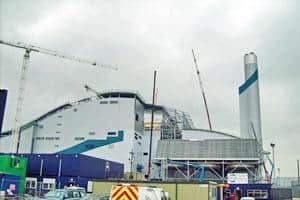
Delivery of the plant had been hampered by delays of over 15 years, after local groups and the London borough of Bexley opposed plans for the development. However, Cory was awarded planning permission for the site in 2006.
Work is being carried out by construction company Costain, which was awarded a £120 million contract to design and build the facility's main buildings in August 2008 (see letsrecycle.com story).Costain was awarded the contract by Swiss energy-from-waste specialist Von Roll Inova, which is set to manage the plant.
Commenting on the construction, Mark Walsh, Cory's project manager for the Belvedere facility, said: “We have got an average of around 850, and up to 1,000, men on site which fluctuates from time-to-time but it is moving things along at a colossal speed.”
“Two years down the line, the site is currently on programme with the delivery timetable. Some are behind time but then there are other elements going faster than expected.”
Development
Licensed to handle 670,000 tonnes of waste each year, Belvedere is also set to accept waste from the London borough of Bexley and the City of London Corporation and is intended to generate 66MW of electricity for export to the National Grid.
Bottom ash produced as a by-product of the incineration process is set to be containerised and taken to recycled aggregates firm Ballast Pheonix at Tilbury Docks in Essex, where it is recycled into construction aggregate.
Inside the plant, work has been completed on the main bunker where waste is stored for use in the energy-from-waste facility. Construction of the bunker took just 28 days as opposed to the usual 12-14 month construction cycle, as it was built using a ‘slip-form' method.
Mr Walsh explained that the method was more expensive but helped galvanise developments, and said: “It was more expensive but we offset that with the time that we managed to save.”
Jetty
The firm completed reinforcement work on Norman Road – the main access point to the 14-acre site – in January 2008 (see letsrecycle.com story) and construction of a bespoke jetty in the Thames has also been completed, with tests on its electrical system set to take place in the coming months.
The 280 metre-long jetty allows Cory to transport large quantities of waste via barges, with the planning consent for the facility predicated on only 80,000 tonnes of material a year entering via Norman Road. This also allows Cory to remove the equivalent of 100,000 HGVs from the road.
Once fully complete, it is expected that 2,100 to 2,200 tonnes of waste-a-day will enter the site via the jetty.
The next major milestone for the Belvedere plant is hot commissioning which is set to take place later this year, in October or November. Hot commissioning is an Environment Agency requirement to show that the boiler can achieve a heat of 850 degrees for two seconds to enable it to handle waste.









Subscribe for free